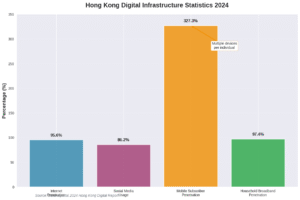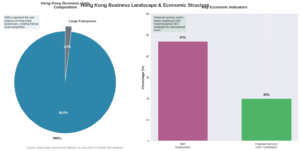Local vs Global SEO: Key Challenges for Hong Kong Businesses
Sep 9, 2025 | 3 Min Read | 1288 Views

Hong Kong businesses face unique challenges when choosing between local and global SEO. Local SEO is vital for small shops and services targeting nearby customers, requiring optimization in both English and Traditional Chinese, plus strong reviews and map visibility in a compact, competitive city. Global SEO matters for finance, tech, and e-commerce brands seeking international reach, demanding multilingual content, cultural adaptation, and technical setups like hreflang. Striking the right balance is key—brands must embrace Hong Kong’s bilingual market, engage local trust signals, and still prepare for cross-border visibility to stand out both locally and worldwide.
I.Introduction
Search engine optimization has evolved from a technical afterthought to a fundamental driver of business visibility and revenue generation. In an era where 99% of people have used the internet to look up information about a local business and 4 out of 5 users conduct searches with local intent, understanding the distinction between local and global SEO becomes crucial for sustainable growth.
The importance of this distinction is amplified in Hong Kong, where businesses must navigate a complex digital ecosystem that serves both hyperlocal consumers and international markets. According to DataReportal’s 2024 Hong Kong Digital Report, Hong Kong boasts an internet penetration rate of 95.6%, with 86.2% of the population active on social media platforms. This exceptional digital connectivity creates both opportunities and challenges for businesses seeking to establish their online presence.
Hong Kong’s unique position as a global financial hub with strong local characteristics presents a distinctive case study in SEO strategy. The territory serves as home to 78 of the top 100 banks in the world and maintains financial services representing over 20% of its $369-billion GDP. This combination of local market density and global significance requires businesses to carefully balance their SEO approaches to maximize both regional dominance and international reach.
II.Defining Local SEO vs. Global SEO
Local SEO: Targeting Geographic Specificity
Local SEO focuses on optimizing online presence to attract customers within specific geographic boundaries. This strategy prioritizes proximity, local relevance, and community-based trust signals to achieve visibility in location-based searches.
Key tactics for local SEO include:
Google Business Profile Optimization: According to BrightLocal’s research, 32% of SEO professionals believe that Google Business Profile is the most essential factor for ranking well in the local map pack
Localized Keywords: Targeting search terms that include geographic modifiers and local intent signals
Customer Reviews Management: With 90% of marketers believing that reviews directly impact local pack rankings
Local Citations and NAP Consistency: Ensuring consistent Name, Address, and Phone number across directories, as businesses with consistent NAP data are 40% more likely to appear in the local pack
Local Link Building: Acquiring backlinks from geographically relevant and authoritative local sources
Global SEO: Achieving International Reach
Global SEO encompasses strategies designed to reach audiences across multiple countries and regions, requiring a more complex approach to language, culture, and technical implementation.
Key tactics for global SEO include:
Multilingual Content Strategy: Creating content that resonates with diverse linguistic and cultural audiences
International Keyword Research: Understanding how search behavior varies across different markets and languages
Hreflang Implementation: Using HTML tags to signal to search engines which language and regional versions of pages to serve to specific audiences
Technical SEO Architecture: Implementing appropriate URL structures (ccTLDs, subdomains, or subdirectories) to organize international content
Cultural Adaptation: Ensuring content aligns with local customs, preferences, and regulatory requirements
The distinction between these approaches becomes particularly relevant when examining research from Manchester Metropolitan University, which found that local SEO recovery tends to be more difficult compared to overall major algorithm updates, due to the historical SEO practices attributed to many small business websites.
III. Hong Kong’s Unique Digital Landscape
Exceptional Digital Infrastructure
Hong Kong’s digital infrastructure represents one of the most advanced in the world. The territory maintains a 97.4% household broadband penetration rate and boasts mobile subscriber penetration of 327.3%, indicating multiple device ownership per individual. This exceptional connectivity creates a highly competitive digital environment where businesses must optimize for multiple touchpoints and platforms.
The mobile-first nature of Hong Kong’s digital consumption is particularly significant, with 30% of all mobile searches being location-related and 88% of consumers who conduct local searches on smartphones visiting or calling stores within 24 hours.

Multilingual Complexity
Hong Kong’s linguistic diversity presents unprecedented challenges for SEO practitioners. The territory operates with three primary languages:
Cantonese: The dominant spoken language, used by approximately 96% of the population
English: The business and legal language, with 53.1% of Hong Kong residents being proficient
Mandarin: Growing in importance, with 48.6% of residents being proficient
This trilingual environment requires businesses to make strategic decisions about language targeting, with research indicating that employers view multilingual capabilities as essential for business success in Hong Kong’s competitive market.
Dense Market Competition
Hong Kong’s compact geography creates an intensely competitive business environment. With Small and Medium Enterprises (SMEs) accounting for 98% of total business units and 47% of total employment, businesses face significant challenges in establishing digital differentiation.
The territory’s 1,104 square kilometers house over 7.49 million residents, creating one of the world’s highest business density ratios. This concentration means that local SEO competition is exceptionally fierce, with businesses competing not just against direct competitors but also against international brands targeting the Hong Kong market.

Platform Preferences and Digital Behavior
Hong Kong users demonstrate distinct platform preferences that impact SEO strategy:
Google Dominance: 88% of people use Google Maps to find local businesses, compared to only 12% using Apple Maps
Social Media Integration: With 86.6% social media usage and users spending an average of 1.7 hours daily across platforms
Mobile-Centric Behavior: 84% of local searches conducted on mobile devices, emphasizing the importance of mobile optimization
IV.Challenges of Local SEO in Hong Kong
Language Barriers and Multilingual Optimization
The necessity to optimize for multiple languages simultaneously creates complex technical and strategic challenges. According to Digitas Hong Kong, businesses must “think about multilingual SEO” and create content in both English and Cantonese to reach their complete audience.
This multilingual requirement extends beyond simple translation. Search behavior patterns differ significantly between languages, with Cantonese speakers often using different query structures compared to English or Mandarin speakers. The challenge is compounded by the need to understand cultural nuances that affect keyword selection and content creation.
Research from academic studies on multilingual SEO indicates that effective multilingual optimization requires understanding the linguistic behavior of users across different languages, as search patterns and preferred terminology can vary dramatically.
Intense Local Competition
Hong Kong’s concentrated market creates unprecedented competitive pressure. With businesses competing within a limited geographic area, achieving local SEO differentiation becomes increasingly challenging. The territory’s high business density means that:
Keyword Competition: Popular local search terms face intense bidding competition
Review Dominance: Businesses must maintain exceptional review scores, as 89% of consumers are more likely to choose businesses that respond to all reviews
Local Pack Visibility: With only three positions available in Google’s local pack, achieving visibility requires exceptional optimization
Local Trust Factors and Social Proof
Hong Kong consumers demonstrate particularly high expectations for local business credibility. Research indicates that 62% of consumers will avoid a local business if they find incorrect information online, making accuracy and consistency critical success factors.
The importance of review management is amplified in Hong Kong’s competitive environment. Businesses must not only generate positive reviews but also demonstrate active engagement with customer feedback. Studies show that 75% of consumers always or often check online reviews when researching local businesses, making reputation management a critical component of local SEO success.
Geographic Density vs. Demographic Diversity
Despite its compact size, Hong Kong encompasses remarkable demographic diversity. The territory serves multiple distinct communities, each with different search behaviors, language preferences, and cultural expectations. This diversity requires businesses to:
Segment Local Audiences: Develop distinct approaches for different demographic groups
Cultural Sensitivity: Ensure content resonates across cultural boundaries while maintaining local relevance
Micro-Location Targeting: Optimize for specific districts or neighborhoods within Hong Kong
V.Challenges of Global SEO from Hong Kong
Cross-border Competition Intensity
Hong Kong businesses pursuing global SEO face competition from both Mainland Chinese companies and established international brands. This creates a three-way competitive dynamic that requires sophisticated positioning and differentiation strategies.
The challenge is exemplified by Airwallex’s international SEO approach, where the FinTech company had to establish distinct regional content strategies across multiple markets while maintaining consistent brand positioning. Their approach included creating country-specific subfolders, with specialized content for Australia, the United States, the United Kingdom, and Hong Kong markets.
Cultural Adaptation Complexity
Global SEO from Hong Kong requires deep understanding of target market cultures, regulations, and business practices. This extends beyond language translation to encompass:
Regulatory Compliance: Understanding data privacy laws, financial regulations, and business requirements across jurisdictions
Cultural Preferences: Adapting content to align with local customs and expectations
Business Practices: Modifying approaches to match local business etiquette and decision-making processes
Technical SEO Implementation Challenges
Implementing global SEO presents significant technical challenges, particularly in:
Hreflang Implementation: Research from Seer Interactive indicates that proper hreflang implementation is critical for international success, yet remains one of the most challenging aspects of global SEO. Hong Kong businesses must ensure proper language and region targeting across their international presence.
Domain Strategy Decisions: Choosing between country-code top-level domains (ccTLDs), subdomains, and subdirectories significantly impacts SEO performance. Search Engine Journal research suggests that each approach has distinct advantages and limitations that must be carefully considered.
Site Architecture Complexity: Managing multilingual, multi-regional websites requires sophisticated technical infrastructure to ensure proper crawling, indexing, and user experience across different markets.
Regulatory and Compliance Considerations
Global expansion requires navigation of complex regulatory environments. Hong Kong businesses must ensure compliance with:
Data Privacy Regulations: Including GDPR in Europe, various state privacy laws in the United States, and emerging privacy regulations across Asia-Pacific markets
Financial Services Regulations: Particularly relevant for Hong Kong’s significant FinTech sector
Content Restrictions: Understanding content limitations and cultural sensitivities across target markets
VI.Strategies to Balance Local and Global SEO
Integrated Keyword Research Strategy
Successful Hong Kong businesses develop comprehensive keyword strategies that address both local and international audiences. This involves:
Local Keyword Optimization: Targeting Cantonese, English, and Mandarin search terms with Hong Kong-specific modifiers and intent signals.
Global Keyword Expansion: Identifying high-value international keywords while understanding regional search behavior variations.
Cross-Language Keyword Mapping: Developing content strategies that address the same topics across multiple languages while avoiding duplicate content penalties.
Google Business Profile Excellence
Optimizing Google Business Profile becomes critical for Hong Kong businesses targeting local audiences. Key strategies include:
Complete Profile Information: Ensuring all business details are accurate and comprehensive, as businesses with complete profiles are 50% more likely to be considered for purchases
Multilingual Descriptions: Creating business descriptions that serve both local and international audiences
Regular Content Updates: Maintaining active profiles with fresh content, photos, and customer interactions
Multilingual Content Architecture
Developing content that serves both local and global audiences requires sophisticated planning:
Content Localization: Moving beyond translation to create culturally relevant content for each target market.
Schema Markup Implementation: Using structured data to help search engines understand content context across languages and regions.
Internal Linking Strategy: Creating logical content relationships that support both local and international SEO objectives.
Strategic Partnership and Link Building
Hong Kong businesses benefit from developing both local and international link building strategies:
Local Partnerships: Collaborating with Hong Kong-based organizations, industry associations, and complementary businesses to build local authority.
International Outreach: Developing relationships with global industry publications, international business directories, and relevant international organizations.
Cross-Border Collaboration: Partnering with businesses in target international markets to develop mutually beneficial link exchanges and content collaborations.
Analytics and Performance Differentiation
Successful businesses implement analytics strategies that clearly differentiate between local and international performance:
Segmented Reporting: Creating distinct analytics views for local Hong Kong traffic versus international visitors.
Conversion Tracking: Understanding how local versus international visitors behave differently and optimizing accordingly.
Market-Specific KPIs: Developing performance indicators that reflect the unique characteristics of each target market.
VIII. Conclusion
The distinction between local and global SEO approaches represents far more than a strategic choice—it defines how businesses connect with their audiences in an increasingly connected yet locally relevant digital landscape. For Hong Kong businesses, this decision carries particular weight given the territory’s unique position as a global financial hub with distinct local characteristics.
Businesses operating in Hong Kong stand at a unique crossroads where local expertise and global ambition intersect. Success requires not just understanding the technical distinctions between local and global SEO, but embracing the cultural intelligence, technical sophistication, and strategic patience necessary to excel in both domains. Those who master this balance will find themselves uniquely positioned to capture the opportunities that emerge from Hong Kong’s distinctive role in the global digital economy.
The future belongs to Hong Kong businesses that can think locally while acting globally, creating digital presences that honor local community relationships while embracing the limitless possibilities of international expansion. In this dynamic environment, SEO becomes not just a marketing tactic, but a fundamental capability that enables businesses to build bridges between local relevance and global impact.
If you’d like to explore sustainable SEO solutions tailored to your business, feel free to reach out to us here.
References
- BrightLocal. (2024). Google’s Local Algorithm and Local Ranking Factors.
- DataReportal. (2024). Digital 2024: Hong Kong — Global Digital Insights.
- Digitas Hong Kong. (2025). Successful SEO Campaign in 2025: Your Guide to SEO.
- Foundation Inc. (2024). Airwallex Rides International SEO Strategy to $5.5B Valuation.
- Keegan, B., & Taylor, J. (2019). Are you local? The challenges of local search engine optimisation strategies. The Journal of Digital and Social Media Marketing, 7(3), 270-280.
- Search Engine Journal. (2018). The Best Practices of Optimizing for International SEO.
- SeoProfy. (2025). 76 Local SEO Statistics for 2025.
- Seer Interactive. (2023). International SEO Hreflang Guide.
- The Visual Realm. (2025). Local SEO: How Reviews Drive Rankings in 2025.
- WhiteSpark. (2023). Local Search Ranking Factors Survey.










